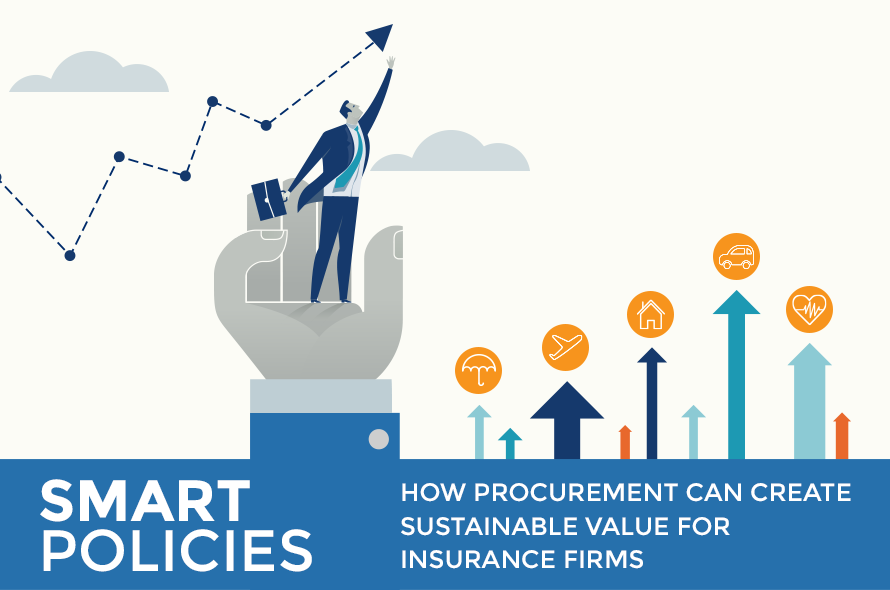Introduction
Insurance carriers are witnessing slow but certain changes to the insurance ecosystem. “Insurtech,” such as telematics and advanced analytics, has been steadily recalibrating consumer expectations; and this, combined with slower economic growth, increased M&A activity and rising regulations, is creating significant challenges for carriers seeking to grow profitably. Extreme financial pressures on the carriers and leadership teams are leading them to look to procurement to help them achieve their financial objectives.
While some procurement organizations have evolved in recent years and become more mature, others have traditionally been doing tactical work: responding to contract requests, running RFPs, and so on. With increased expectations from leadership teams, procurement is being challenged to play a more strategic role and come up with new ways to optimize the total supplier cost while still meeting business objectives.
In this white paper, we discuss key levers beyond traditional methods of cutting costs which procurement can use to significantly reduce total claims costs, mitigate supply risk and enhance the customer experience.
Insurance carriers heavily rely on outsourcing vendors to help run their business smoothly. These suppliers are tightly integrated into the core business processes, so the traditional procurement approach of moving business to the most cost-effective firms may not always be possible, as it can negatively impact customer experience. However, if procurement plays a more strategic role in identifying new ways to optimize costs and collaborate with the claims department, it can bring tremendous value to the table.
There are three key levers that procurement can use to identify new ways of optimizing total claims cost:
- Technology and automation
- Benchmarking
- Leveraging advanced analytics to reduce claims litigation costs
Technology and Automation
The insurance industry is changing at an unprecedented rate, with new tools and technologies being introduced every day to help make claims professionals’ lives easier. Procurement should be in the forefront in researching new tools and technologies, and understanding how these tools impact customer satisfaction and total claims spend.
In the case of roofing claims, modern technologies like aerial imaging can have a significant positive impact on timelines and costs. Aerial imaging automatically feeds roof measurement data into the estimating system, which significantly reduces the amount of work required by an adjuster, automates the entire process and achieves lower cycle times, adjusting costs, and indemnity costs.
If an adjuster performs the estimation and overestimates the material requirement, the insurer incurs the cost of unused material, which can lead to indemnity costs spiraling out of control. If the material requirement is underestimated, this can lead to reinspection and longer cycle times, which adversely impact customer satisfaction. Aerial imaging provides a more accurate measurement, helping insurers not only achieve significant savings, but higher levels of customer satisfaction as well.
Video collaboration, another technological advance, allows desk adjusters to write estimates remotely and eliminates the need to send out an adjuster to the property for small-value claims, which further reduces adjusting cost.
Category specialists can be of great value to insurance carriers because they supply market intelligence on a continuous basis for new tools and technologies that help reduce cycle times, vendor spend and indemnity costs. The inputs from these category specialists can help claims professionals identify the right tools and technologies and gain competitive advantage in the marketplace.
Benchmarking
As the insurance industry becomes more competitive, chief claims officers increasingly have been asking themselves, “Are my financials and processes in line with those of my competitors?” Benchmarking can answer this question through comparison of a company’s contracted rates, guidelines and service-level agreements (SLAs) with best-in-class rates, guidelines and SLAs.
Procurement can add clear value by benchmarking current rates and identifying existing opportunities for quick wins and savings across the claims organization. But going beyond benchmarking simple rates, benchmarking SLAs and making sure the ones at your organization are best-in-class can help reduce not only expenses, but also indemnity costs. As an example, spend and quality can be greatly improved by having clear and stringent SLAs in the contracts with repair contractors. If repair work is not started within a clearly defined timeline, not only could your customer’s experience be negatively impacted, but the severity of damage could increase due to the contractor taking longer than others to complete the job. A carrier wouldn’t just end up paying for a costlier job — it would also be required to provide temporary accommodation, further boosting indemnity costs.
Benchmarking guidelines or clear scopes of work in the contract with the suppliers can also help drive significant savings by identifying specific responsibilities or duties that could potentially be eliminated for small value claims. Having a reduced scope of work in the contract provides additional leverage when negotiating per-claim pricing with suppliers.
Leveraging advanced analytics to reduce claims litigation costs
Optimization of litigation costs can prove to be extremely challenging because of the balance litigation managers have to strike between pricing and effectiveness. If a firm has lower hourly rates, but is inefficient and charges more hours than it should, it could still drive up the total fees. Or, if a litigation firm has lower hourly rates but is not able to achieve favorable outcomes, it could send litigation costs skyrocketing. Therefore, the traditional approach of minimizing costs through rate reductions alone may not be the most effective tactic.
Today, advanced analytics have led to innovative methods for optimizing overall litigation costs. These methods include law firm scorecarding and alternative fee arrangements.
-
Law firm scorecarding
Law firm scorecarding is a very effective way of capturing law firms’ performance in a holistic manner. Once a case is closed, case handlers rate law firms on various criteria such as communication, timeliness, and outcome. These ratings can then be used to arrive at a single score using a weighted average which serves as an indicator of the firm’s overall performance. Litigation managers can use these ratings to provide feedback to the firms and assign cases to the more effective and efficient firms, or remove a firm from the panel counsel list where necessary.
-
Alternative fee arrangements
Analyzing average fees per case for recurring legal defense cases can provide valuable insights, such as whether a flat-fee model is more cost-effective for a particular law firm and for particular types of cases. Similar analyses can be conducted for blended-fee model and other alternative fee arrangements as well. An analysis of average fees for recurring and low-dollar defense cases can help uncover any opportunities to be realized from moving such defense cases to the most efficient firm.
While all of these levers can deliver significant savings, it is important to recognize that success factors such as support from the leadership team and collaborative efforts between procurement and claims lay a strong foundation for these cost-optimization initiatives to be effective.
Key Success Factors
- The leadership team must support the collaborative efforts between procurement and claims
- Procurement and claims stakeholders should take joint ownership of cost reduction and program goals
- A strong program governance infrastructure should be in place to ensure that all the objectives of the program are met and the program strategy is aligned with the overall business strategy
Conclusion
In our experience, implementing these levers — technology and automation, benchmarking, advanced analytics geared toward reducing claims litigation costs — can deliver 10-20 percent savings for insurance carriers. These tactics also help mitigate supply risk, reduce cycle time and improve customer satisfaction. If procurement, as part of its evolving role in the insurance industry, can drive adoption of innovative methods and processes through collaboration with claims and potentially other functions too, it will find itself in the highly desirable position of having a direct and positive impact on top-line growth as well as its traditional bottom-line target.

